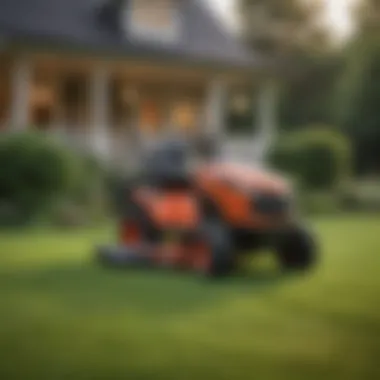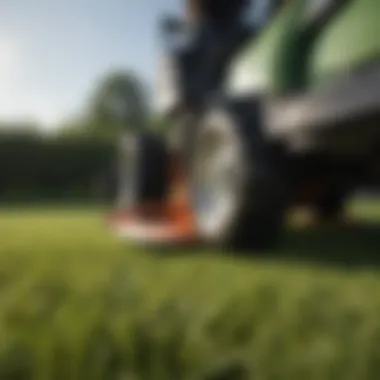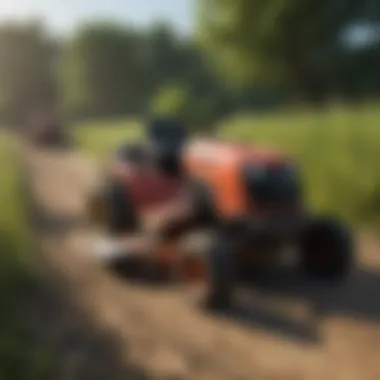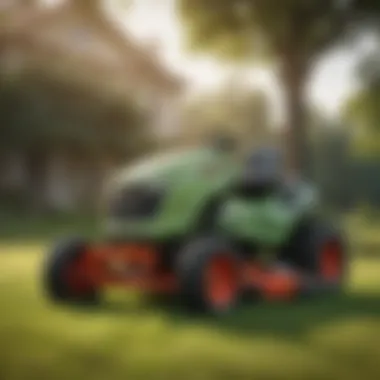Top Riding Lawn Mowers with Maximum Deck Height


Intro
Riding lawn mowers with high deck heights play an essential role in maintaining large lawns, agricultural fields, and horticultural landscapes. This article investigates the importance of deck height and its significant impact on mowing efficiency and grass health. Deck height refers to the distance between the ground and the cutting deck of the mower. A higher deck height often allows for the cutting of taller grasses without scalping, providing a cleaner cut and reducing stress on the grass. This consideration is vital, not just for maintaining aesthetic landscapes but also for promoting overall turf health.
Definition of Key Terms
When discussing riding lawn mowers, it is critical to understand specific terms. Here are a few definitions:
- Deck Height: The measurement from the ground to the lowest point of the mower's cutting deck.
- Mowing Efficiency: Refers to how effectively a mower can cut grass while minimizing time, fuel consumption, and potential damage to grass.
- Scalping: A mowing error that removes too much grass, leading to potential harm in the lawn by exposing soil.
Relevance in Agriculture, Horticulture, and Agronomy
In the fields of agriculture and horticulture, the choice of mowing equipment can significantly impact productivity and sustainability. Professionals in these areas often prioritize tools that offer flexibility in cutting heights to adapt to varying grass types and growth patterns. By selecting mowers with higher deck heights, users can minimize the need for frequent mowing, reduce soil compaction, and promote healthier grass growth. Thus, understanding the implications of deck height is crucial for farmers and horticulturalists aiming to optimize their land while maintaining best practices.
Intro to Riding Lawn Mowers
The choice of riding lawn mowers can greatly impact the efficiency and effectiveness of lawn care. Knowing the significant features and benefits of these machines is essential for users, particularly in fields such as agriculture and horticulture. This section will elaborate on what defines riding lawn mowers and why deck height is a critical factor in choosing the right equipment.
Defining Riding Lawn Mowers
Riding lawn mowers are specialized equipment designed for larger areas of grass. Unlike push mowers, these machines allow the operator to sit while mowing. This increases comfort, reduces fatigue, and enhances productivity. Riding mowers vary in terms of design, power, and functionality, making them suitable for different terrains and mowing requirements. Typical features include adjustable cutting heights, various engine options, and maneuverability suited for tight spaces. The shift towards riding mowers in both residential and commercial settings reflects a growing demand for efficiency in lawn maintenance tasks.
Importance of Deck Height
Deck height is one of the pivotal features of riding lawn mowers. Higher deck heights provide several advantages: a greater cutting capacity, the ability to handle uneven terrains, and minimized grass scalp.
To thoroughly understand the impact of deck height, one must consider the following aspects:
- Cutting Efficiency: A higher deck allows for cutting grass more evenly, reducing the occurrence of uneven patches.
- Grass Health: Cutting grass too short can damage the roots and create a dry lawn. Higher cutting heights maintain healthier grass, which is particularly beneficial during dry seasons.
- Adaptability: Machines with higher deck heights perform better across a variety of terrains. Mistakes from running too low on uneven ground can harm both the mower and the grass.
In summary, deck height influences not only the immediate appearance of the lawn but also long-term health. The right riding lawn mower can make a significant difference, making it essential for users to carefully consider their options.
Understanding Deck Height
Understanding deck height is essential for anyone serious about lawn care. It affects how well a riding mower performs, especially in varying conditions and terrains. An appropriate deck height ensures optimal cutting and helps maintain grass health. When you choose a mower with a higher deck height, it allows for more flexibility in how the mower operates, accommodating thicker grass and rougher terrain.
What Constitutes Deck Height?
Deck height refers to the distance from the ground to the lowest point of the mower deck. This measurement has a direct impact on the cut of the grass. A higher deck height means the mower can cut grass more efficiently without scalping. This is particularly important in uneven terrains where dips and bumps are present. Another important point to note is that different mower models have varying deck heights, impacting their effectiveness.
Several factors contribute to defining deck height in riding lawn mowers:
- Mower Type: Commercial versus residential mowers often have different design standards.
- Adjustability: Some models allow for height adjustments, giving users more control.
- Cutting Style: Whether the mower is set for a more aggressive cut or a level trim can influence how deck height is perceived.
In sum, the construction and adjustability of the deck height plays a pivotal role in lawn care efficiency.
Measuring Deck Height Accurately
Measuring deck height accurately is crucial for proper lawn maintenance. Improper measurements could lead to suboptimal cutting results. To ensure accuracy, follow these steps:
- Prepare the Mower: Ensure the mower is on a flat surface. This prevents any errors caused by incline.
- Use a Measuring Tool: A ruler or tape measure can work well. Measure from the ground to the bottom of the mower deck.
- Check Multiple Points: Different areas of the deck might have slight variations. Measure at least two points for accuracy.
- Record the Measurements: Keep a log of your findings for future reference. This is especially beneficial when adjusting heights periodically.


"An accurate measurement provides the basis for effective lawn care and optimal mower performance."
When done correctly, measuring deck height will provide valuable insights into how to set the mower for different types of grass and terrains. Maintaining the right deck height ultimately contributes to the mower’s longevity and the health of the grass.
Advantages of Higher Deck Heights
The height of a riding lawn mower's deck has significant implications for its performance and functionality. Higher deck heights provide distinct advantages that can enhance mowing capability, operational efficiency, and overall lawn health. As we delve into this aspect, it becomes clear that understanding these benefits is crucial for both casual users and professionals in agriculture and horticulture.
Improved Mowing Efficiency
One of the primary reasons for choosing a mower with a high deck height is the improved mowing efficiency it offers. With increased clearance, the mower can easily navigate uneven terrain, tall grass, and various types of obstacles, while also reducing the chances of scalping your lawn.
A higher deck allows the mower blades to operate effectively without coming into contact with the ground or other surfaces. This ensures a cleaner cut, allowing for a precise and uniform mow. As a result, users often find that they can complete their mowing tasks more quickly. The time saved translates into less fuel consumption, which can lead to cost savings on fuel and maintenance.
Additionally, the adjustable deck heights available on many higher-end models empower users to adapt their mowing practices based on grass type and season. This adaptability enhances overall mowing efficiency, ensuring optimal results year-round.
Enhanced Grass Health
The benefits of higher deck heights extend beyond just operational efficiency; they also significantly impact grass health. When the mower is set to a higher cut, it helps maintain longer grass blades, which can promote healthier growth. Longer blades can better photosynthesize, yielding a greener and more resilient lawn.
Higher deck settings contribute to minimizing stress on the grass, particularly during hot and dry conditions. The taller grass provides shade for the roots, which helps to retain soil moisture, essential for healthy grass development. This staying power during challenging weather also reduces the likelihood of weeds taking hold, as thicker grass can outcompete them for resources.
"Higher deck heights not only enhance operational efficiency, but they also promote better grass health by allowing longer blades to thrive."
Furthermore, maintaining taller grass can encourage beneficial organisms in the soil, such as earthworms, which play a vital role in soil aeration and health. Overall, optimizing deck height is an essential aspect of effective lawn care, ensuring both efficiency and lush growth.
In summary, the advantages of higher deck heights in riding lawn mowers rest on improved efficiency and the promotion of a healthier lawn. As both professionals and enthusiasts consider their equipment options, understanding these benefits can guide their decision-making process for better results.
Key Features of Leading Models
In the realm of riding lawn mowers, understanding the key features of leading models is essential. High deck heights significantly influence the efficiency of lawn care. A mower's capability to maintain proper grass height while ensuring effective cutting is determined by its design and functions. Users should prioritize features that enhance performance, reliability, and ease of use. Factors such as engine power, cutting width, and overall weight balance play a pivotal role in determining a model's suitability for specific tasks.
Top Models Overview
Several models stand out in the market when considering high deck heights. Notable brands such as Husqvarna, Cub Cadet, and John Deere have designed machines that offer exceptional cutting capabilities. These mowers often come equipped with advanced technology, making them versatile for different mowing conditions. Each model provides unique attributes tailored to various user needs.
Comparative Analysis of Features
Engine Power
When assessing the engine power, it is crucial to understand its contribution to overall performance. A powerful engine ensures that the mower can tackle dense or uneven terrain without stalling. For instance, many models from Husqvarna feature engines that provide reliable horsepower, allowing them to cut through thick grass effortlessly. A key characteristic of these engines is their reliability and durability over extended use.
However, users must consider that a more powerful engine may consume more fuel, which can be a drawback for those looking for eco-friendly options.
Cutting Width
The cutting width is another important aspect, influencing how much area can be mowed in one pass. Wider cutting widths can significantly improve mowing efficiency, especially in large lawns. Mowers from Cub Cadet often provide options with impressive cutting widths, reducing the time spent mowing. A unique feature of wide cutting decks is their capacity to provide an even cut, which is beneficial in achieving a professional lawn appearance. On the downside, users with smaller properties may find wide models cumbersome to maneuver in tight spaces.
Weight and Balance
The weight and balance of a riding mower directly affect its handling and stability. Models designed with a lower center of gravity tend to offer better control during operation. For example, John Deere mowers are well-known for their balanced design, enabling users to navigate slopes and uneven ground safely. The key characteristic here is the overall distribution of weight, which plays a vital role in preventing tipping and enhancing user comfort. While heavier mowers may offer stability, they can be more challenging to transport and store.
"Choosing the right riding lawn mower involves understanding the unique features that cater to individual lawn care needs."
Performance in Various Conditions


Understanding how riding lawn mowers perform in different conditions is essential for effective lawn care. This section delves into two crucial components: turf types and terrain considerations, along with the impact of weather conditions. Both elements directly influence how efficiently a mower operates.
Turf Types and Terrain Considerations
Different types of grass require unique mowing approaches. For instance, Bermuda grass thrives in warmer climates and prefers a lower cutting height. On the other hand, fescue grass is suited for cooler environments and benefits from higher cutting settings. Choosing a mower with adjustable deck heights is particularly beneficial. It allows the operator to adapt the mowing height based on the grass type, ensuring optimal results without damaging the turf.
Moreover, the terrain plays a pivotal role in performance. Steep slopes and uneven surfaces can challenge a mower's stability and cutting effectiveness. Models designed for hilly landscapes often feature enhanced traction and better weight distribution. Considering these factors can help in selecting the right mower for specific lawn conditions.
Weather Impact on Mowing
Weather conditions can significantly affect lawn care routines. Wet grass can lead to clumping, resulting in uneven cuts that require more time to correct. Mowing during damp conditions can also lead to increased wear on mower blades. Therefore, understanding the local weather patterns is paramount for effective lawn maintenance.
In contrast, dry and sunny weather promotes cleaner cuts and faster grass drying times. However, mowing in extreme heat can stress the grass. Operators should aim to mow during the cooler parts of the day, such as early morning or late afternoon, to minimize such stress.
"The right timing and conditions can transform mowing from a chore into an efficient task, enhancing not only the lawn's appearance but also its health."
It is also important to note how seasonal changes affect mowing practices. Spring may require a more frequent cutting schedule due to faster grass growth. In the fall, the need for efficient leaf mowing becomes evident as leaves accumulate on the lawn.
By recognizing and adapting to these variables, users can maintain lawn health and maximize mower performance.
User Considerations
When selecting a riding lawn mower, the user considerations become crucial. These considerations affect both the performance and longevity of the mower. Understanding the specifics regarding use and maintenance can greatly enhance the mowing experience. Here, we delve into two key aspects: best practices for use and maintenance, and common issues and solutions that the user might encounter.
Best Practices for Use and Maintenance
To ensure optimal performance of riding lawn mowers with high deck heights, it is vital to follow best practices.
- Pre-Mowing Inspection: Always inspect the mower before use. Check the oil levels, blade sharpness, and tire pressure. A well-maintained mower performs better and lasts longer.
- Mowing Technique: Use the right mowing technique. Mow in straight lines and overlap slightly with each pass. This helps to achieve an even cut and improves the health of the grass.
- Cutting Height Adjustment: Set the cutting height according to grass type and growth. For instance, tall grasses may require higher cutting heights to avoid stress on the plants.
- Regular Cleaning: After mowing, take the time to clean debris from the mower deck. This prevents clogging and maintains optimal performance.
- Seasonal Maintenance: Keep up with seasonal servicing. This includes changing the oil and filters as well as sharpening the blades at least twice a year. Regular maintenance prolongs the life of the mower and improves performance.
- Ensure the air filter is clean. A clogged air filter can reduce efficiency.
Common Issues and Solutions
Every mower user encounters issues. Knowing common problems and their solutions can save time and frustration.
- Engine Starting Problems: If the engine does not start, it could be due to a dead battery or fuel issues. Ensure the battery is charged, and check for proper fuel delivery.
- Uneven Cutting: If you notice uneven grass heights, check the blade height adjustment. Additionally, ensure blades are sharp and not damaged.
- Mower Overheating: Overheating can occur from blocked air intakes or low oil levels. Regular cleaning and timely oil checks will help prevent this problem.
- Tire Issues: Flatted or improperly inflated tires can cause handling issues. Check and maintain tire pressure regularly.
- Poor Grass Discharge: If clippings do not discharge correctly, the mower may be clogged. Remove the clippings and check the chute for blockages.
Understanding these user considerations aids in maximizing the value of a riding lawn mower. By adhering to best practices and familiarizing oneself with common issues, owners can ensure a productive mowing experience.
Sustainability Aspects
Sustainability in lawn care is becoming more essential as environmental concerns rise. Riding lawn mowers with higher deck heights offer specific advantages in this regard. Using these mowers can lead to more efficient grass cutting without overwhelming the blade or soil. This reduces emissions and fuel consumption because the mower does not require frequent passes over the same area.
Moreover, higher deck heights allow for taller grass maintenance, and this, in turn, promotes better grass health. Taller grass can retain moisture better and provide a cooler environment for soil. This helps in water conservation, reducing the need for excessive irrigation. Understanding the role of sustainability in lawn care enables users to make informed choices that benefit both their properties and the planet.
Environmental Impact of Lawn Care Equipment
The environmental impact of lawn care equipment is significant. Traditional mowers often consume large amounts of fossil fuels and emit carbon emissions, contributing to air pollution. Riding lawn mowers with the highest deck heights can alleviate some of these issues. By promoting healthier grass growth, they reduce the frequency of mowing required.
Here are some specific environmental benefits:
- Reduced emissions from less frequent mowing.
- Lower fuel consumption due to larger cutting decks.
- Minimized use of fertilizers; healthier grass needs less chemical input.


"Adopting eco-friendly lawn care techniques not only benefits the environment but also enhances the sustainability of agricultural practices."
Investing in modern mowers that prioritize sustainability can lead to long-term benefits. Users can achieve a balance between effective lawn care and environmental responsibility.
Innovations in Eco-Friendly Mowers
Innovations in eco-friendly mowers are reshaping the lawn care industry. Many manufacturers are designing equipment that focuses on sustainability while maintaining performance. These innovations include electric riding lawn mowers that operate quietly and emit no pollutants. They also incorporate advanced battery technology to extend running time.
Furthermore, some models utilize solar energy to reduce reliance on fossil fuels. These advancements benefit users and align with growing environmental standards.
Consider these features when searching for eco-friendly options:
- Battery-powered systems for zero emissions during operation.
- Mulching capabilities to recycle grass clippings and enrich soil.
- Efficient engine designs that enhance fuel economy.
As the demand for sustainable solutions rises, manufacturers are responding with smarter, greener alternatives. Consumers have the opportunity to choose equipment that meets both their functional needs and their commitment to sustainability.
Future Trends in Lawn Mowing Technology
Riding lawn mowers are evolving significantly, driven by advances in technology and shifts in consumer demand. The exploration of future trends in lawn mowing technology reflects a critical aspect of this evolution. Understanding these trends can assist consumers and professionals alike to make informed decisions. As we navigate changes in lawn care, it is vital to recognize how innovations can optimize mowing efficiency and reduce environmental impact.
Automation and Robotics in Lawn Care
Automation in lawn care introduces a paradigm shift. Riding mowers are increasingly equipped with robotic features that allow them to operate with minimal human intervention. This automation is not just a luxury; it addresses practical challenges. For instance, robotic mowers can operate during off-hours, minimizing disruption and allowing for more flexible schedules.
- Key benefits of automation include:
- Time Savings: Robotic mowers free up valuable hours for homeowners or professionals, allowing focus on other tasks.
- Precision: Automated systems typically employ GPS and other technologies to ensure uniform mowing patterns, enhancing lawn quality.
- Safety: Reduced reliance on manual operation lessens the risk of accidents in high-traffic areas.
However, the integration of these technologies requires consideration of maintenance and updates. Users must ensure that software is current, and machinery is regularly serviced to sustain performance.
Integration of AI for Enhanced Performance
The integration of artificial intelligence in riding lawn mowers is a burgeoning field. AI can analyze various factors such as grass type, moisture levels, and even historical performance data to optimize mowing schedules and techniques.
- Some significant advantages of AI integration include:
- Custom Adaptation: Mowers can adjust their performance based on real-time analysis, which can extend their lifespan and improve mowing results.
- Resource Management: Enhanced calculation can lead to lower fuel consumption and reduced wear on equipment, aligning with sustainability goals.
- User-Friendly Interfaces: Many modern mowers now feature intuitive interfaces that allow for easy adjustments and monitoring by users, making complex technology accessible to a broader audience.
"Technology should respond to the user’s needs, adapting seamlessly to enhance the mowing experience."
As these technologies evolve, it is essential for users to remain informed and adaptable. Embracing these trends can lead to substantial improvements in both the efficiency of lawn maintenance and the ecological footprint of lawn care activities.
The End and Recommendations
In the context of riding lawn mowers with high deck heights, the conclusion section serves as a critical understanding of the key takeaways from this article. Such insights play an essential role for readers aiming to make informed purchasing decisions. With various models available, it is vital to distill the comprehensive data and user experiences into actionable guidance.
The recommendations are tailored to assist both professionals in agriculture and homeowners looking for efficient mowing solutions. Selecting an appropriate riding lawn mower combines various factors, including deck height, performance in differing conditions, and sustainability aspects. It is not merely about finding a mower with the highest deck height; rather, it is equally important to consider the overall efficiency and health of the lawn across varied terrains, which can enhance both user satisfaction and operational productivity.
The height of the cutting deck is directly linked to mowing efficiency, making this an imperative consideration in any purchase.
Summary of Key Insights
- Deck Height Matters: Higher deck heights allow for better cutting efficiency, especially in uneven terrains. A mower's design should not compromise its ability to maintain an optimal grass height.
- Specific Models Stand Out: Certain brands and models consistently outperform others in capability and durability. Noteworthy examples include products from John Deere and Cub Cadet, which maintain high user reviews due to their robust designs and effective features.
- User Experience is Critical: Looking into feedback from other users offers invaluable insights into the performance over time. Engaging with communities online can enrich understanding and inform better choices.
- Environmental Concerns: Eco-friendly options are becoming increasingly relevant. Customers are more inclined to consider models that integrate sustainable technologies, thereby having a lesser environmental impact.
Guidelines for Selecting the Right Model
- Assess Your Lawn Type: Different types of grass and terrains require different mowing approaches. Select a model that is suitably engineered for your specific environment.
- Deck Height Flexibility: Consider mowers that have adjustable deck heights. This feature offers versatility for changing lawn conditions and personal preferences.
- Performance Features: Investigate the engine power, cutting width, and weight of the mower. These elements significantly impact efficiency and usability.
- Maintenance and Service: Understanding the service options available for a model can save you time and cost in the long run. Ensure that the brand provides adequate support and spare parts accessibility.
- Budget Considerations: While it is tempting to opt for advanced features at a higher price, finding a well-balanced model that meets your needs without excessive spending is advisable.
By synthesizing these insights and guidelines, buyers can navigate the complex landscape of riding lawn mowers to make an informed and strategic decision suitable for their mowing needs.



